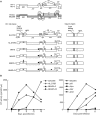Rhesus M1.3S Cells Suitable for Biological Evaluation of Macaque-Tropic HIV/SIV Clones
- PMID: 21747811
- PMCID: PMC3128997
- DOI: 10.3389/fmicb.2011.00115
Rhesus M1.3S Cells Suitable for Biological Evaluation of Macaque-Tropic HIV/SIV Clones
Figures

References
-
- Doi N., Fujiwara T., Adachi A., Nomaguchi M. (2010). Growth ability in various macaque cell lines of HIV-1 with simian cell-tropism. J. Med. Invest. 57, 284–292 - PubMed
-
- Fujita M., Yoshida A., Sakurai A., Tatsuki J., Ueno F., Akari H., Adachi A. (2003). Susceptibility of HVS-immortalized lymphocytic HSC-F cells to various strains and mutants of HIV/SIV. Int. J. Mol. Med. 11, 641–644 - PubMed
LinkOut - more resources
Full Text Sources

